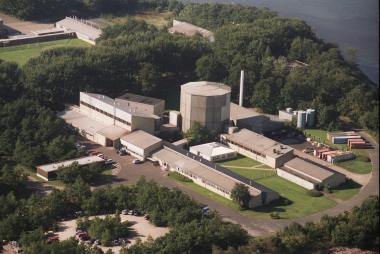Six sites up for Danish nuclear repository
05 May 2011
Six potential locations for a repository for Denmark's low- and intermediate-level radioactive waste have been identified in a study submitted to the country's government.
 |
DR-3 - one of Denmark's three research reactors
(Image: Dansk Dekommissionering
|
Denmark never implemented a commercial nuclear power program but operated a total of three scientific research reactors over the period from the late-1950s up to 2000, as well as associated fuel fabrication facilities. All three reactors – DR-1, DR-2 and DR-3 – were located at the Risø National Laboratory north of Roskilde on the island of Zeeland. Most of the used fuel from the reactors has been returned to the USA, but the country still has a sizeable amount of low and intermediate level radioactive waste which is being stored at Risø pending the selection and construction of a final repository.
A major step towards that repository has been made with the submission of three pre-feasibility studies to the Danish interior and health ministry. The first study, prepared by national decommissioning body Dansk Dekommissionering (DD), looks at different disposal concepts in terms of types of repository, waste conditioning, safety analyses, costs and long-term impact assessments. The second study, prepared by the Danish national institute for radiation protection, (Statens Institut for Strålebeskyttelse, SIS), addresses likely radiation doses from the transport of waste from Risø to the repository. The third study, prepared by the Geological Survey of Denmark and Greenland (GEUS), concerns the location of the repository.
Overall, the studies conclude that a moderately deep repository would be the most appropriate from a security point of view, although this would be more expensive than a near-surface repository. From 22 areas suggested in preliminary studies, the reports recommend that six potential sites are taken forward for further study.
The six are: Østermarie, in the Bornholm municipality, an island region to the east of Denmark and south of Sweden; Rødbyhavn in Lolland, another island municipality to the south of the Danish capital Copenhagen; Kertinge Mark, in the municipality of Kerteminde, on the east coast of central Denmark; Hvidbjerg, in the Struer municipality, in western central Denmark; and two locations in the Skive municipality, also in western central Denmark, at Thise and Sive Vest.
The six identified locations will now be narrowed down to a shortlist of two or three by an inter-ministerial working group in a process that will include the affected municipalities and regions. The Danish government will also propose a special planning act for the two or three shortlisted areas to provide the basis for comprehensive environmental impact assessment studies and a public consultation phase before a final decision on the location is taken. The entire process is expected to take years, the Danish interior and health ministry warns.
Welcoming the progress made towards achieving a repository, interior and health minister Bertel Haarder said that it was crucial that Denmark deal with the "relatively modest" amounts of radioactive waste that it has, in a transparent process working by consensus.
The three reports, plus a summary of the studies, are available on the Danish Ministry of Interior and Health website.
Researched and written
by World Nuclear News